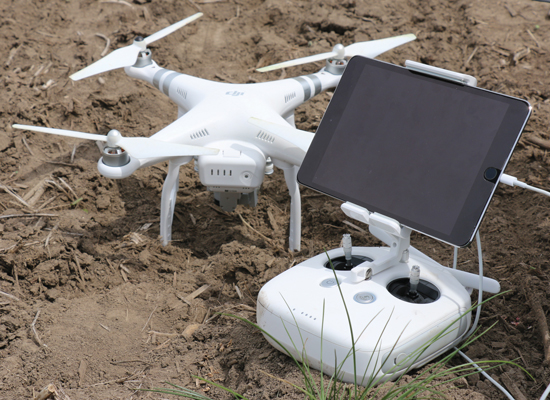
Shifting needs in agriculture spell jobs for professionals with tech training.
According to a 2013 analysis from researchers at the University of Minnesota, the global population is set to grow and urbanize so much by 2050 that producers will need to generate 87 percent more rice, wheat, soy and corn than they do today.
At the same time, a more affluent global society will consume more animal protein. The World Health Organization estimates meat consumption will rise to almost 100 pounds per person per year by 2030, up from 80 in the late 1990s.
The challenge for production to keep pace with these demands is almost unfathomable, but it’s a major driving force for growth and innovation in the agriculture industry—and that means jobs. But those jobs won’t just be in production. After all, there’s not enough high-quality land to grow 87 percent more crops. The need for innovation to meet these demands means jobs in agriculture are changing, becoming more specialized and increasingly technical.
Thinking Bigger in Ag
Tami Craig Schilling wants people to think bigger when it comes to careers in agriculture. “When you think about the role agriculture plays in Illinois and the region, people don’t realize how many jobs are dependent or related to it,” says the nearly 28-year Monsanto employee, now serving in the role of agronomy knowledge transfer lead.
“If you think about inputs that go into agriculture, whether it’s equipment, biological products, fertilizers, or fuels to keep machines moving, those are all jobs. And if you add in the agency work—soil and water conservation agencies, USDA—these are good, stable jobs,” Craig Schilling says, “and there are just a lot of them.”
The U.S. Bureau of Labor Statistics corroborates her view, for the most part. While jobs for agricultural workers and farm managers are not projected to grow between now and 2026, jobs for agricultural scientists and engineers, conservation and environmental scientists, chemists, hydrologists, regional planners and data analysts are all set to rise.
Craig Schilling points specifically to the rise of digital technologies in agriculture as a trend to watch. “The amount of money that has gone into ag venture capital over the last two years is just jaw-dropping,” she says. “And investors are putting their money in interesting places: it’s IT, digital and data analytics—solving problems with new tools. These investments are a clear signal to me that there are going to be jobs in these career areas.”
 Trending: Ag Engineering and Technology
Trending: Ag Engineering and Technology
Scott Dixon took his agricultural engineering background to Caterpillar 12 years ago, and now works as a senior analytics project leader for Caterpillar’s Simulation Center, located in the Research Park at the University of Illinois. He has specialized in construction and mining machinery, but has never let go of his roots in agriculture.
“Some of the strongest growth areas for careers in agriculture will benefit professionals that hold expertise both in the industry and also in technology,” Dixon says. “These emerging roles will serve as integrators which will help take technology and data analytics from proof-of-concept to a viable product which can scale and is purpose-built for the agriculture industry.”
According to AgCareers.com, the agricultural technology job outlook is particularly good for geospatial and IT analysts, IT programmers and software developers, and precision agriculture specialists. AgCareers places the average salary for professionals in the sector at $74,300.
“In my career I have seen telematics and data collection turn the corner from being a cool new technology or toy you could show your neighbors, to critical assets which generate inputs for a more efficient business,” he adds.
Computer Science +
Recognizing that technology and data are increasingly integral to agriculture, universities are starting to design blended training programs to prepare young people for an evolving workforce. For example, the University of Illinois’ Department of Computer Science and College of Agricultural, Consumer and Environmental Sciences (ACES) have introduced a first-of-its-kind major built on that relationship. Starting in the fall of 2018, students will be able to enroll in the new CS + Crop Sciences undergraduate program at the university—one of a growing number of CS + X degrees at U of I.
According to Germán Bollero, Associate Dean for Research in the College of ACES, agriculture’s growing reliance on technology is producing vast amounts of data—from molecular genetics, the study of weather and the climate, GIS-based data gathering, and the many applications of drones. “The generation of huge data sets has expanded the demand for people with the skills to integrate computer science and agriculture,” he explains.
The Department of Animal Sciences at U of I is looking into developing a similar degree. “The animal industry is looking for students who have skills in precision animal agriculture, bioinformatics, web programming and data analysis,” says David Miller, professor of animal sciences. “Our goal is to provide a program for students who are interested in these career fields.”
According to Rodney Johnson, head of the Department of Animal Sciences, “Virtually all stages of production, from animal genetics and nutrition to management of the animal environment, have potential to be digitally integrated. This emerging area can provide new means and methods for producers to further optimize management of resources, improve animal health and well-being, improve meat quality, and remain productive in a changing climate.”
Jobs in agriculture may not fall into the same categories they did 20 years ago, but Tami Craig Schilling points out a pattern that has remained consistent over time. “I think people in ag get into this work because they want to make a difference… to do something bigger than themselves. Ag offers that opportunity. It’s pretty awe-inspiring to me.” iBi

